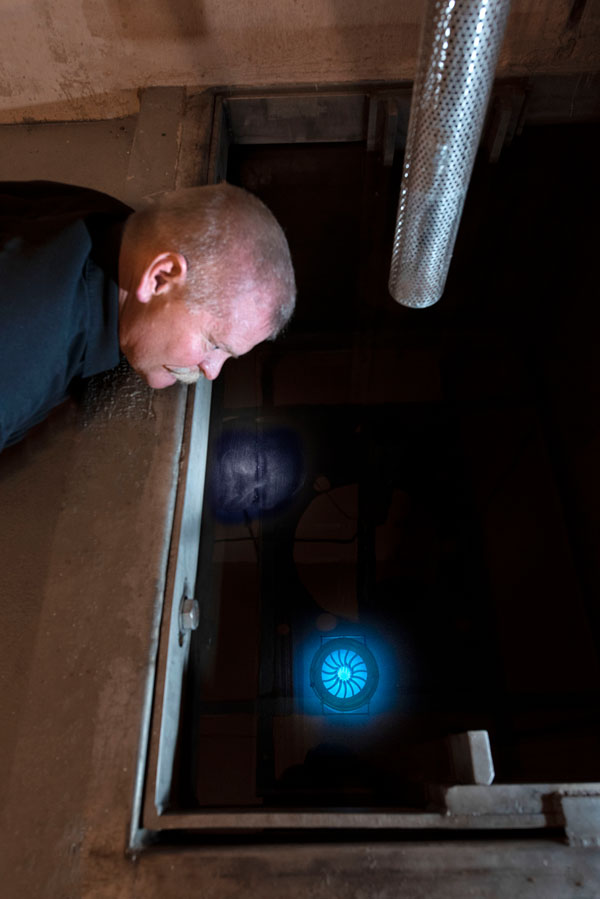Sandia, university partnership allows institutions to share knowledge

Sandia and the University of New Mexico are joining forces to bolster national security and advance science and engineering under an agreement signed earlier this month.
“Once we have that umbrella in place, it opens the knowledge cache of both institutions — our scientific researchers collaborating with UNM’s — so that we can better serve Albuquerque, the state and the nation,” said Sandia business development specialist Jason Martinez.
The umbrella Cooperative Research and Development Agreement, or CRADA, allows the Labs and university to explore research collaborations among scientists, faculty and students in several areas, including ongoing projects. In contrast to a standard CRADA, which involves a single project in one technical area, an umbrella CRADA covers multiple projects and technologies.
The CRADA with UNM will immediately launch two projects focusing on radiation testing and developing particle detector designs for the European particle physics laboratory CERN.
“CRADA research like this fosters innovation and furthers the capabilities of both parties,” said Sandia technology partnerships senior manager Mary Monson. “These partnerships allow Sandia to share our expertise for the U.S. public good and support the Labs’ various missions.”
The CRADA will last five years and can be renewed. The agreement bolsters the collaboration the Labs and UNM have had as part of the Sandia Academic Alliance Program, an initiative formed with five universities to promote collaborative research and attract top talent to work on these tough problems.
The agreement with UNM could serve as a model for other Academic Alliance partners, said Diane Peebles, Sandia’s New Mexico partnership manager. Sandia’s other Academic Alliance partners are the Georgia Institute of Technology, the University of Illinois at Urbana-Champaign, Purdue University and the University of Texas at Austin.
The UNM umbrella CRADA has nine areas of collaboration: quantum information science; computational science and engineering; cybersecurity; data analytics, systems analysis and intelligence science; nuclear engineering and high-energy density science; advanced materials and devices; energy and water; bioscience for national security; and emerging science and engineering capabilities for national security.
“This continues our long-standing collaboration with UNM and is a big step forward in the partnership,” Diane said. “This allows Sandia to collaborate in an in-kind way with UNM faculty and students.”
For example, the CRADA will build on partnerships between Sandia and the university at the Center for Quantum Information and Control, co-located at UNM and the University of Arizona; at the Advanced Materials Laboratory, a research facility jointly operated by Sandia and UNM; and at the New Mexico EPSCoR SMART Grid Center, a project that includes Sandia, UNM and several other research institutions.
Materials validated for Large Hadron Collider use
In one of the first projects under the umbrella CRADA, Sandia will test and validate electronics and other materials UNM uses to develop advanced particle detector designs for the Atlas Detector on the Large Hadron Collider at CERN, headquartered in Geneva, Switzerland. Atlas has been used in several well-known physics investigations, from the search for the Higgs boson to dark matter particles.
Electrical components and other materials need to withstand harsh radiation fields during experiments at the Large Hadron Collider, said Maryla Wasiolek, a Sandia nuclear engineer on the project. The collider is undergoing energy and luminosity upgrades that will expose particle detector components to higher levels of incident radiation.
The UNM components will be tested at Sandia’s Gamma Irradiation Facility and the Ion Beam Laboratory to predict their responses to the experimental conditions similar to those that may be present when the Large Hadron Collider restarts operations. The results will be shared with several programs requiring radiation-hardened detectors, electronics and materials.
Another project will allow Sandia to assist UNM researchers with characterizing fuel plates used to power the university’s low-power teaching reactor, said Sandia engineer John Miller.
The project, supported by the DOE’s Criticality Safety Program, will support the development of benchmarks for the Nuclear Energy Agency’s International Handbook of Evaluated Criticality Safety Benchmark Experiments, which is used to validate nuclear data. Having those benchmarks, John said, will benefit both institutions and the nuclear community.
“In the world of nuclear criticality safety, we’re always trying to ensure people handle material in a safe manner,” John said. “We have the radiological protection people who can do the characterization, we have nuclear safety experts and we have the measurement capabilities that UNM needs, while they have a reactor with uncommon fuel.”
John pointed out that the UNM teaching reactor is a low-power reactor used for teaching and research: “If it was working at full capacity, it could barely power an LED.” LEDs are light-emitting diodes.
John said there’s a chance that once the project and associated training are complete, UNM could inherit surplus equipment from Sandia that would allow it to make additional measurements. That exchange of expertise, equipment and knowledge was a driving force for the agreement.
“We want to have these interactions with UNM and other universities to meld complementary skills in the pursuit of science,” he said. “We are excited to be working with UNM, bringing our expertise to help characterize their training reactor.”